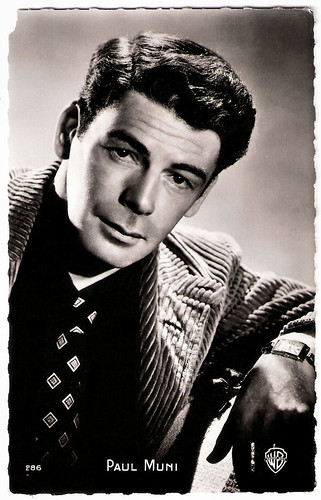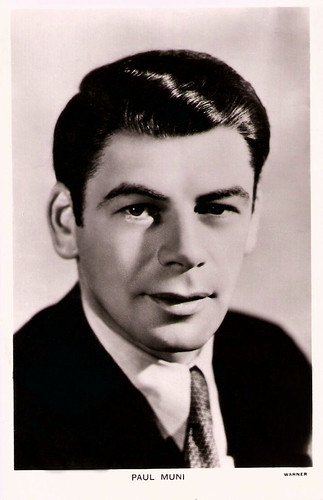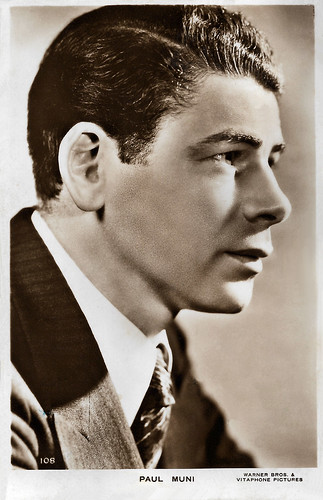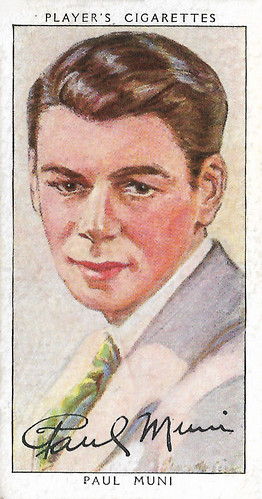Paul Muni (1895-1967) was an American stage and film actor who was nominated five times for the Academy Awards. He won the Oscar for Best Actor for his role in The Story of Louis Pasteur (William Dieterle, 1936). During the 1930s, he was considered one of the most prestigious actors at the Warner Bros. studio, and was given the rare privilege of choosing which parts he wanted.

French postcard by Editions P.I., Paris, no. 286. Photo: Warner Bros.
Paul Muni was born Frederich Meshilem Meier Weisenfreund in 1895 in Lwów Lemberg, Galicia, a province of the Austro-Hungarian Empire (now Lviv, Ukraine). His parents were Salli and Phillip Weisenfreund, both actors in a travelling Yiddish repertory company. He learned Yiddish as his first language. The family immigrated to America in 1899.
The Weisenfreund family settled in Chicago, where Paul grew up. He started his acting career in the Yiddish theatre with his parents. Naturally talented in acting, he wanted to become a professional actor but this was unacceptable to his father who wanted his son to become a musician. However, Muni was adamant and his father reluctantly agreed to let him pursue his passion.
As a teenager, he developed a skill in creating makeup, which enabled him to play much older characters. At the age of 12, he played the stage role of an 80-year-old man. He was quickly recognised by Maurice Schwartz, who signed him up with his Yiddish Art Theatre in New York in 1918. After 4 years, he moved to other Yiddish theatres until 1926.
Paul Muni was a very reserved and shy person in real life. In 1921, he married Bella Finkel, an actress in the Yiddish theatre. They remained married until Muni's death in 1967.
Muni began acting on Broadway in 1926. His first role was that of an elderly Jewish man in the play We Americans, written by playwrights Max Siegel and Milton Herbert Gropper. It was the first time that he ever acted in English.
In 1929, Muni was signed by Fox. His name was simplified and anglicised to Paul Muni (he had the nickname 'Moony' when he was young). His acting talents were quickly recognised and made his film debut in the drama The Valiant (William K. Howard, 1929) with Marguerite Churchill. For his portrayal of a murderer, he received an Oscar nomination, although the film did poorly at the box office.
In his second film Seven Faces (Berthold Viertel, 1929), he played seven different characters. He was given the nickname "The New Lon Chaney", but the film was again a financial failure. Unhappy with the roles offered to him, he returned to Broadway, where he starred in a major hit play, Counselor at Law (1931-1933).
Paul Muni soon returned to Hollywood to star as the cruel, explosive gangster Antonio 'Tony' Camonte in the original Scarface (Howard Hawks, 1932), part of a cycle of gangster films at the time. The film was written by Ben Hecht, who based his screenplay on Armitage Trail's 1929 novel of the same title, which is loosely based on the rise and fall of Al Capone.
The plot centres on Camonte, who aggressively and violently moves up the ranks in the Chicago gangland world. A version of the Saint Valentine's Day Massacre is depicted. A man of 5'9" height (175.3 cm), Muni wore small lifts (adding three or four inches) and padding to appear more hulking and ape-like as Tony. The film was the basis for Scarface (Brian De Palma, 1983) starring Al Pacino.
In the crime drama I Am a Fugitive from a Chain Gang (Mervyn LeRoy, 1932), he played a wrongfully convicted convict on a chain gang who escapes to Chicago. For his role, Muni was nominated for an Oscar for Best Actor. Audiences in the United States who saw the film began to question the legitimacy of the United States legal system, and in January 1933, the film's protagonist, Robert Elliott Burns, who was still imprisoned in New Jersey, and a number of other chain gang prisoners nationwide in the United States, were able to appeal and were released.
The acclaim that Paul Muni received as a result of this performance so impressed Warner Bros., they signed him to a long-term contract, publicising him as "the screen's greatest actor".

British postcard in the Picturegoer Series, no. 838. Photo: Warner.

British Real Photograph postcard, no. 108. Photo: Warner Bros. Vitaphone Pictures.
During the 1930s, Paul Muni became one of the most prestigious actors at the Warner Bros., and was given the rare privilege of choosing which parts he wanted. His reputation as a prominent stage actor prevented Hollywood from molding him into a marketable image or into a typical big-screen leading man. Muni’s film roles were diverse and generally superior to most Hollywood fare.
In 1935, Muni starred as a coal miner involved in a union dispute in Black Fury (Michael Curtiz, 1935) with Karen Morley, and for his performance he earned his third Oscar nomination (as a write-in candidate).
Muni persuaded Warner Bros. to take a financial risk by producing the historical biography The Story of Louis Pasteur (William Dieterle, 1935). Muni played the 19th century chemist who developed major advances in microbiology, which revolutionised agriculture and medicine, to prove that his medical theories will save lives. It was first of Muni's many biographical roles. The sudden success of Pasteur gave Warner's 'box office gold'. For his performance, Muni won an Oscar and the Volpi Cup for Best Actor from the Venice Film Festival.
Muni played other historical figures, including French author Émile Zola in The Life of Emile Zola (William Dieterle, 1937), for which he was nominated for an Oscar. The film won Best Picture and was interpreted as indirectly attacking the repression of Nazi Germany. He also played the lead role as the Mexican national hero Benito Juárez in Juarez (William Dieterle, 1939) opposite Bette Davis.
His acting quality, usually playing a powerful character, was partly a result of his intense preparation for his parts, often immersing himself in study of the real character's traits and mannerisms. He was also highly skilled in using makeup techniques, a talent he learned from his parents, who were also actors, and from his early years on stage with the Yiddish theatre in Chicago.
In 1937, Muni played a Chinese peasant, with a new bride, in a film adaptation of Pearl Buck's novel The Good Earth (Sidney Franklin, 1937). It co-starred Luise Rainer as his wife. She won an Academy Award for her part. The film was a recreation of a revolutionary period in China, and included special effects for a locust attack and the overthrow of the government.
Dissatisfied with life in Hollywood, Muni chose not to renew his contract. He returned to the screen only occasionally in later years, for such roles as Frédéric Chopin's teacher in A Song to Remember (Charles Vidor, 1945) with Merle Oberon. In 1946, he starred in a rare comic performance, Angel on My Shoulder (Archie Mayo, 1946), playing a gangster whose early death prompts the Devil (played by Claude Rains) to make mischief by putting his soul into the body of a judge. His new identity turns the former criminal into a model citizen.
In 1946, he appeared on Broadway in A Flag is Born, written by Ben Hecht, to help promote the creation of a Jewish state in Israel. This play was directed by Luther Adler and co-starred Marlon Brando. At London's Phoenix Theatre, in 1949, Muni began a run as Willy Loman in the first English production of Death of a Salesman by Arthur Miller. He took over from Lee J. Cobb, who had played the principal role in the original Broadway production. Both productions were directed by Elia Kazan.
In Italy, he appeared in the drama Imbarco a mezzanotte/Stranger on the Prowl (Joseph Losey, 1952). Muni travelled to Italy to star in the film partly as an act of solidarity and support for blacklisted friends living there in exile.
A few years later, during 1955 and 1956, Muni had his biggest stage success in the United States as the crusading lawyer, Henry Drummond (based on Clarence Darrow), in Inherit the Wind, winning a Tony Award for Best Performance by a Leading Actor in a Play. In late August 1955, Muni was forced to withdraw from the play, due to a serious eye ailment causing deterioration in his eyesight.
His last film role was as a crusading doctor in The Last Angry Man (Daniel Mann, 1959), and he was again nominated for an Oscar. After that, Muni mostly retired from acting to deal with failing eyesight and other health problems.
Over the years, he became increasingly dependent on his wife, Bella, a dependence which increased as his failing eyesight turned to blindness in his final years. He made his final screen appearance on television, in a guest role on the dramatic series Saints and Sinners (1962).
Paul Muni died of a heart disorder in Montecito, California, in 1967. He was 71 and had made 22 films and also starred in numerous Broadway plays. He is interred in the Hollywood Forever Cemetery, Hollywood.

British cigarette card in the Third Film Stars series by John Player & Sons, no. 32. Photo: Warner - First National. Collection: Geoffrey Donaldson Institute.
Sources: Encyclopaedia Britannica, Biography.com, Wikipedia and IMDb.

French postcard by Editions P.I., Paris, no. 286. Photo: Warner Bros.
A cruel, explosive gangster
Paul Muni was born Frederich Meshilem Meier Weisenfreund in 1895 in Lwów Lemberg, Galicia, a province of the Austro-Hungarian Empire (now Lviv, Ukraine). His parents were Salli and Phillip Weisenfreund, both actors in a travelling Yiddish repertory company. He learned Yiddish as his first language. The family immigrated to America in 1899.
The Weisenfreund family settled in Chicago, where Paul grew up. He started his acting career in the Yiddish theatre with his parents. Naturally talented in acting, he wanted to become a professional actor but this was unacceptable to his father who wanted his son to become a musician. However, Muni was adamant and his father reluctantly agreed to let him pursue his passion.
As a teenager, he developed a skill in creating makeup, which enabled him to play much older characters. At the age of 12, he played the stage role of an 80-year-old man. He was quickly recognised by Maurice Schwartz, who signed him up with his Yiddish Art Theatre in New York in 1918. After 4 years, he moved to other Yiddish theatres until 1926.
Paul Muni was a very reserved and shy person in real life. In 1921, he married Bella Finkel, an actress in the Yiddish theatre. They remained married until Muni's death in 1967.
Muni began acting on Broadway in 1926. His first role was that of an elderly Jewish man in the play We Americans, written by playwrights Max Siegel and Milton Herbert Gropper. It was the first time that he ever acted in English.
In 1929, Muni was signed by Fox. His name was simplified and anglicised to Paul Muni (he had the nickname 'Moony' when he was young). His acting talents were quickly recognised and made his film debut in the drama The Valiant (William K. Howard, 1929) with Marguerite Churchill. For his portrayal of a murderer, he received an Oscar nomination, although the film did poorly at the box office.
In his second film Seven Faces (Berthold Viertel, 1929), he played seven different characters. He was given the nickname "The New Lon Chaney", but the film was again a financial failure. Unhappy with the roles offered to him, he returned to Broadway, where he starred in a major hit play, Counselor at Law (1931-1933).
Paul Muni soon returned to Hollywood to star as the cruel, explosive gangster Antonio 'Tony' Camonte in the original Scarface (Howard Hawks, 1932), part of a cycle of gangster films at the time. The film was written by Ben Hecht, who based his screenplay on Armitage Trail's 1929 novel of the same title, which is loosely based on the rise and fall of Al Capone.
The plot centres on Camonte, who aggressively and violently moves up the ranks in the Chicago gangland world. A version of the Saint Valentine's Day Massacre is depicted. A man of 5'9" height (175.3 cm), Muni wore small lifts (adding three or four inches) and padding to appear more hulking and ape-like as Tony. The film was the basis for Scarface (Brian De Palma, 1983) starring Al Pacino.
In the crime drama I Am a Fugitive from a Chain Gang (Mervyn LeRoy, 1932), he played a wrongfully convicted convict on a chain gang who escapes to Chicago. For his role, Muni was nominated for an Oscar for Best Actor. Audiences in the United States who saw the film began to question the legitimacy of the United States legal system, and in January 1933, the film's protagonist, Robert Elliott Burns, who was still imprisoned in New Jersey, and a number of other chain gang prisoners nationwide in the United States, were able to appeal and were released.
The acclaim that Paul Muni received as a result of this performance so impressed Warner Bros., they signed him to a long-term contract, publicising him as "the screen's greatest actor".

British postcard in the Picturegoer Series, no. 838. Photo: Warner.

British Real Photograph postcard, no. 108. Photo: Warner Bros. Vitaphone Pictures.
Louis Pasteur
During the 1930s, Paul Muni became one of the most prestigious actors at the Warner Bros., and was given the rare privilege of choosing which parts he wanted. His reputation as a prominent stage actor prevented Hollywood from molding him into a marketable image or into a typical big-screen leading man. Muni’s film roles were diverse and generally superior to most Hollywood fare.
In 1935, Muni starred as a coal miner involved in a union dispute in Black Fury (Michael Curtiz, 1935) with Karen Morley, and for his performance he earned his third Oscar nomination (as a write-in candidate).
Muni persuaded Warner Bros. to take a financial risk by producing the historical biography The Story of Louis Pasteur (William Dieterle, 1935). Muni played the 19th century chemist who developed major advances in microbiology, which revolutionised agriculture and medicine, to prove that his medical theories will save lives. It was first of Muni's many biographical roles. The sudden success of Pasteur gave Warner's 'box office gold'. For his performance, Muni won an Oscar and the Volpi Cup for Best Actor from the Venice Film Festival.
Muni played other historical figures, including French author Émile Zola in The Life of Emile Zola (William Dieterle, 1937), for which he was nominated for an Oscar. The film won Best Picture and was interpreted as indirectly attacking the repression of Nazi Germany. He also played the lead role as the Mexican national hero Benito Juárez in Juarez (William Dieterle, 1939) opposite Bette Davis.
His acting quality, usually playing a powerful character, was partly a result of his intense preparation for his parts, often immersing himself in study of the real character's traits and mannerisms. He was also highly skilled in using makeup techniques, a talent he learned from his parents, who were also actors, and from his early years on stage with the Yiddish theatre in Chicago.
In 1937, Muni played a Chinese peasant, with a new bride, in a film adaptation of Pearl Buck's novel The Good Earth (Sidney Franklin, 1937). It co-starred Luise Rainer as his wife. She won an Academy Award for her part. The film was a recreation of a revolutionary period in China, and included special effects for a locust attack and the overthrow of the government.
Dissatisfied with life in Hollywood, Muni chose not to renew his contract. He returned to the screen only occasionally in later years, for such roles as Frédéric Chopin's teacher in A Song to Remember (Charles Vidor, 1945) with Merle Oberon. In 1946, he starred in a rare comic performance, Angel on My Shoulder (Archie Mayo, 1946), playing a gangster whose early death prompts the Devil (played by Claude Rains) to make mischief by putting his soul into the body of a judge. His new identity turns the former criminal into a model citizen.
In 1946, he appeared on Broadway in A Flag is Born, written by Ben Hecht, to help promote the creation of a Jewish state in Israel. This play was directed by Luther Adler and co-starred Marlon Brando. At London's Phoenix Theatre, in 1949, Muni began a run as Willy Loman in the first English production of Death of a Salesman by Arthur Miller. He took over from Lee J. Cobb, who had played the principal role in the original Broadway production. Both productions were directed by Elia Kazan.
In Italy, he appeared in the drama Imbarco a mezzanotte/Stranger on the Prowl (Joseph Losey, 1952). Muni travelled to Italy to star in the film partly as an act of solidarity and support for blacklisted friends living there in exile.
A few years later, during 1955 and 1956, Muni had his biggest stage success in the United States as the crusading lawyer, Henry Drummond (based on Clarence Darrow), in Inherit the Wind, winning a Tony Award for Best Performance by a Leading Actor in a Play. In late August 1955, Muni was forced to withdraw from the play, due to a serious eye ailment causing deterioration in his eyesight.
His last film role was as a crusading doctor in The Last Angry Man (Daniel Mann, 1959), and he was again nominated for an Oscar. After that, Muni mostly retired from acting to deal with failing eyesight and other health problems.
Over the years, he became increasingly dependent on his wife, Bella, a dependence which increased as his failing eyesight turned to blindness in his final years. He made his final screen appearance on television, in a guest role on the dramatic series Saints and Sinners (1962).
Paul Muni died of a heart disorder in Montecito, California, in 1967. He was 71 and had made 22 films and also starred in numerous Broadway plays. He is interred in the Hollywood Forever Cemetery, Hollywood.

British cigarette card in the Third Film Stars series by John Player & Sons, no. 32. Photo: Warner - First National. Collection: Geoffrey Donaldson Institute.
Sources: Encyclopaedia Britannica, Biography.com, Wikipedia and IMDb.
No comments:
Post a Comment